All You Need to Know About Altered Wheelbase Cars
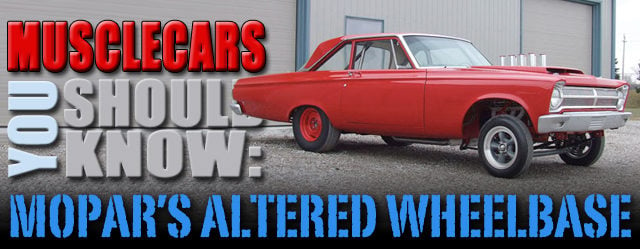 By the mid-1960s the musclecar era was starting to striking its stride, and drag strip bragging rights had developed into a proven marketing tactic. The NHRA'southward Super Stock and A/Factory Experimental (A/FX) classes were among the well-nigh hotly contested battlegrounds in drag racing at the time, giving the mill teams high visibility to amateur racers and potential garden-variety buyers alike while also showcasing the latest hardware that the companies had in development.
By the mid-1960s the musclecar era was starting to striking its stride, and drag strip bragging rights had developed into a proven marketing tactic. The NHRA'southward Super Stock and A/Factory Experimental (A/FX) classes were among the well-nigh hotly contested battlegrounds in drag racing at the time, giving the mill teams high visibility to amateur racers and potential garden-variety buyers alike while also showcasing the latest hardware that the companies had in development.
The 1964 race flavour had been proficient to Chrysler. The new 426 Hemi motor had taken the motorsport world past storm, setting records in NASCAR and finding success in both of the aforementioned NHRA classes, breaking national records at the drag strip equally well. But the other factory teams weren't going to take this Mopar authorisation lying down.
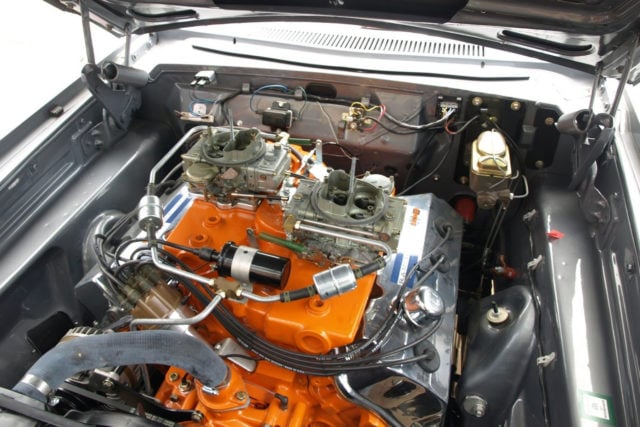
The 426 Hemi was a bonafide sensation right out of the gate, breaking records in both NASCAR and at the elevate strip. Only racing was big business past the mid-1960s, and competitors like Ford weren't content to let Chrysler hog the limelight. When discussion got around that Ford was prepping a new SOHC 427 for use in the Mustang and Comet – cars that were significantlly smaller and lighter than the Coronet and Belvedere – Chrysler'southward engineers knew they would need to exercise something pretty radical to stay ahead. Epitome: FCA
When give-and-take got out that Ford was planning to equip its smaller Mustang and Comet bodies with a stiff single overhead cam, 427-cube motor for employ in the Factory Experimental class for the 1965 season, the engineers at Chrysler knew they were going to have to have drastic measures if wanted to proceed the larger Mopars alee of those Fords.
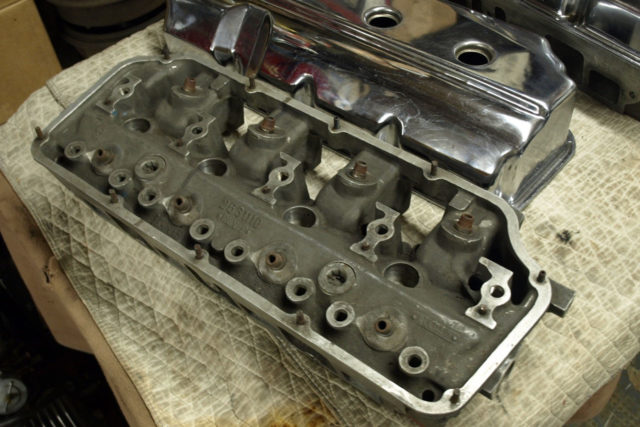
Function of Chrysler's strategy for the upcoming 1965 race season was to drop as much weight from the cars as possible – particularly at the nose. While the 1965 Race Hemi cylinder heads were essentially identical to their 1964 counterparts from a design and performance standpoint, they differed in that aluminum had replaced cast iron as the cloth of selection. The weight of each caput dropped from threescore to 27 pounds from that modify alone, resulting in a 66 pound weight reduction at the front of the car overall. Image: FCA
Jim Thornton, a Chrysler chassis engineer, was well aware that weight distribution was the central to getting the Hemi'southward power to the ground out of the hole, especially when contending with the archaic tire technology that was available at the time. Merely the new power plant was simply a massive, heavy motor that added a meaning corporeality of weight to the nose of the automobile in comparison to the engine it had supplanted for Chrysler's racing program, hindering those weight transfer efforts.
To address this, Chrysler expanded its use of lightweight aluminum and fiberglass for body panels, replaced the door window glass with Plexiglass and the windshield with Lexan, while the engine team took some mass out of the 426 with a new set of aluminum cylinder heads and a magnesium cross-ram intake manifold. Simply the Coronet and Dais racers were still considered too nose heavy, so Thornton decided to go several steps farther to distribute more of the automobile'southward weight over the rear wheels.
The Original "Funny Cars"
While the Super Stock class rules yielded elevate cars that shared the majority of their hardware with models and equipment that were bachelor to the public, the A/FX grade was significantly less restricted, allowing teams to develop packages that those companies never had any intention of offering through their dealerships.
Belatedly in 1964, Thornton and the other engineers in Chrysler's Race Group decided that the most effective manner to distribute the auto's mass to the rear was to move the wheelbase equally far frontward as possible.
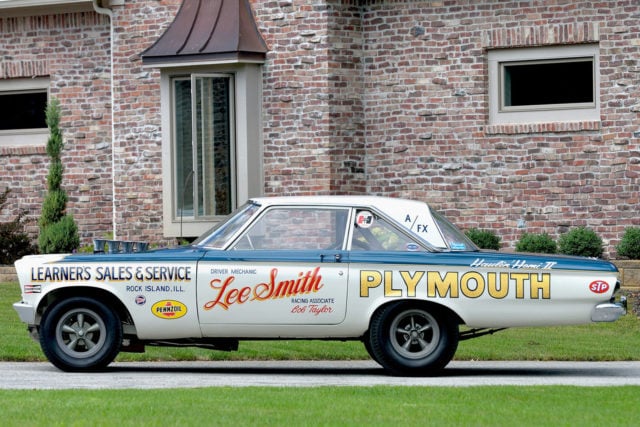
Back in the 1960s tire technology was however fairly archaic, and even full-bore race slicks had problem putting the Hemi's prodigious grunt to the pavement. Chrysler was among the most adventurous of the factory teams when information technology came to experiments with weight distribution – come across the Hemi Under Glass for some other bang-up example of their out-of-the-box thinking. The company's extreme measures with the altered wheelbase cars might not have gone over well with NHRA officials, but the oddball Mopars were undeniably fast and quickly gained a massive enthusiast following in match racing. Epitome: Mecum
To practice so they brought the front wheels up by 10 inches and moved the rear axle forward by 15 inches while shortening the overall wheelbase length by v.5 percent. The end result was a 110-inch wheelbase drag machine that put 56% of the mass over the rear tires, weight distribution that was unheard of at the time.
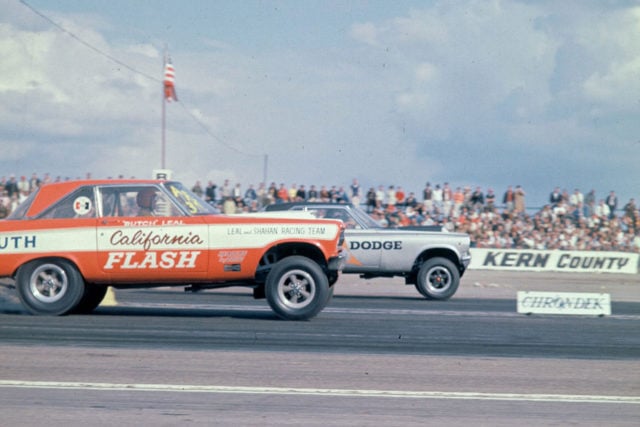
Outfitted with a cross ram intake and dual four-barrel carbs, the altered wheelbase Mopars were dishing out depression ten-second quarter mile times right out of the gate in the AHRA'south Mill Experimentals class they raced in, and would become even quicker once Chrysler green-lit the switch to Hilborn fuel injection during the season. As theorized, the standard wheelbase Mopars left to battle it out in the NHRA's A/FX form struggled against the lighter Mustangs and Comets.
Five Dodge Coronets and 5 Plymouth Belvederes were allocated for the conversion, having their steel bodies acrid dipped and then sent out to Amblewagon in Detroit for their altered wheelbase conversion before beingness delivered to mill squad racers like Dick Landy, Ronnie Sox, and Al Eckstrand.
While there was no question that the altered wheelbase cars were significantly faster than their standard model counterparts, the Chrysler squad hit a serious roadblock once NHRA got their kickoff look at the new cars. Officials speedily drafted a new rule for 1965 that restricted wheelbase alterations to two percentage versus stock for the A/FX grade, effectively banning the altered wheelbase Mopars from the class they were designed to compete in.
Simply the cars' wild appearance and impressive operation garnered massive publicity from the enthusiast press, and the cars quickly became a massive hit running match races in the popular and lucrative AHRA Mill Experimentals course around the state, where capacity crowds would turn upward to see drivers similar Roger Lindamood, Dave Strickler, and Bud Faubel pilot these "funny cars" to low ten second passes at nearly 140 mph. The cars got even faster one time the teams switched over to Hilborn fuel injection systems mid-flavour in 1965.
The ten B-bodies earmarked for A/FX racing in the 1965 season had their bodies acrid dipped and and then were sent off to Amblewagon in Detroit for the altered wheelbase conversion. Along with a spartan interior that was devoid of animal comforts like air conditioning and a radio - forth with a lack of passenger and rear seats - aluminum and fiberglass body panels replaced steel where e'er possible. A Lexan windshield and Plexiglas side and rear windows replaced the glass normally used. Images: Mecum
Legacy
Though the term would somewhen be adopted by fiberglass bodied, tube-chassis dragsters in the years following, the altered wheelbase Mopars of the mid-1960s serve every bit the origin of the Funny Car term and remain some of the wildest factory-modified production cars built to engagement.
As privateer teams started to get in on the altered wheelbase act, many would add high riding straight axle front end suspensions to the equation. Along with adding some other layer of visual oddity to the the cars, this setup promoted weight transfer to the rear and was lighter than the conventional front suspension setup. Images: Hemmings
With the popularity of Chrysler's factory-built altered wheelbase Coronets and Belvederes, private teams quickly began edifice funny cars of their ain, and the contradistinct wheelbase craze speedily spread not only to other Mopar models simply other makes too.
Today, altered wheelbase cars continue to flourish in nostalgia classes across the land. But with less than a dozen of the factory-build cars in existence, and each with a notable racing history, the value of the original Chrysler altered wheelbase cars has only risen over the decades since their debut, with examples like Lee Smith'due south Haulin' Hemi Two Plymouth Dais commanding sums well over half a 1000000 dollars at recent auctions.
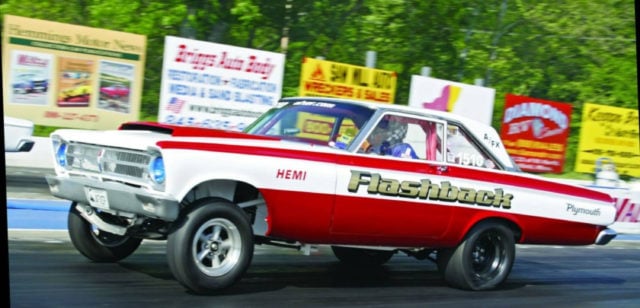
Farthermost rarity coupled with racing full-blooded and motorsport success means that the original factory-produced contradistinct wheelbase Dodges and Plymouths are worth a hefty sum today. However, while more difficult to build that a standard wheelbase example, AWB clones like the one above have kept these cars reasonably accessible for those who want to experience what Factory Experimental race classes were like back in the day. Image: Hemmings
While the performance of the AWB cars would be eclipsed non long after their debut as more avant-garde technologies found their mode into drag racing, their unusual pattern strategy and wild appearance remains iconic for a specific fourth dimension and place in drag racing history, and the fact that they immediately ran afoul of NHRA guidelines immediately upon their debut feels strangely similar to a situation that a recently-unveiled Mopar now finds itself in. The more than things alter…
Source: https://www.streetmusclemag.com/features/car-features/muscle-cars-you-should-know-chrysler-altered-wheelbase-drag-cars/
0 Response to "All You Need to Know About Altered Wheelbase Cars"
Post a Comment